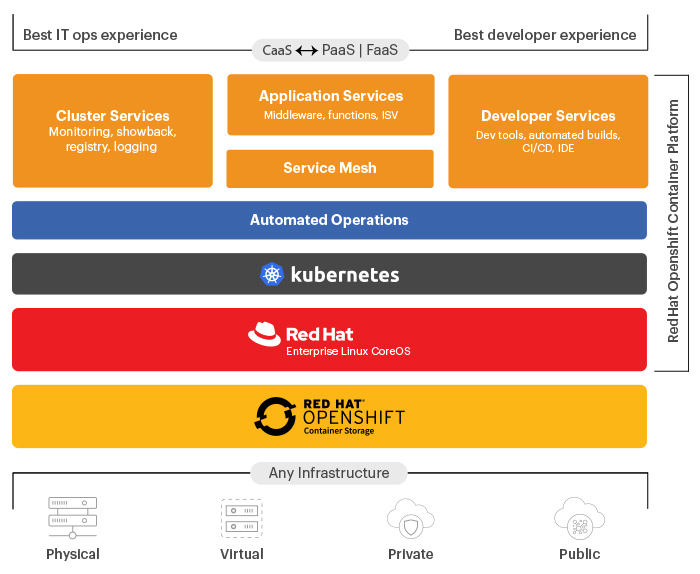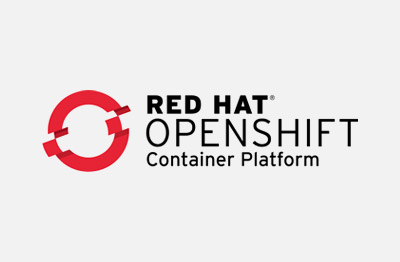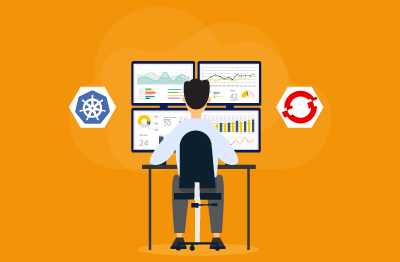OpenShift
What is OpenShift? What is Red Hat OpenShift?
Over the last couple of years, Kubernetes (often called K8s) has become the most popular and well-known container orchestration system for automating application deployment, scaling, and management. Scheduling containers at scale in a cloud-native ecosystem is central to the technology. Kubernetes itself is an open-source project, and as such presents challenges for many enterprises, especially in regulated industries with strong security requirements and formal SLA commitments.
Red Hat have developed a paid for commercially available product, Red Hat OpenShift, around core Kubernetes to better suit the need of enterprises that offers additional security controls, UI features, a ready-to-go CI/CD integration solution, container management features and most importantly full enterprise support contracts with Red Hat committed to resolve issues.
A free, unsupported open-source community version of OpenShift is also available, called OKD (Origin Community Distribution), and is the upstream, community-driven project used to develop and maintain OpenShift.
Red Hat OpenShift can provide developers with a cloud-like experience wherever it is deployed. It can be used in the cloud, on-premises or as hybrid-cloud or multi-cloud deployment. It provides developers with a consistent application platform across different environments for building, deploying, managing and scaling applications.
What's the difference between OpenShift and OKD?
Red Had maintain a page that outlines the differences between OpenShift and OKD and the benefits of OpenShift vs. OK, see: Red Hat OpenShift vs. OKD.
How does OpenShift differ from managed Kubernetes services?
Red Hat OpenShift differs from managed Kubernetes services such as Amazon EKS, Azure Kubernetes Service (AKS) or Google Kubernetes Engine (GKE) by providing multi-tenancy options, more advanced security, integrated storage and a CI/CD pipeline as standard.
In fact, all the major public clouds also offer a managed OpenShift option, for example, ROSA (Red Hat OpenShift on Amazon). The pricing on these cloud hosted versions of OpenShift vary.
What does OpenShift do and what is it used for?
Red Hat OpenShift delivers a complete application platform for both traditional and cloud-native applications, allowing them to run anywhere. Built on Red Hat Enterprise Linux and compatible with Red Hat Ansible Automation Platform, Red Hat OpenShift enables automation inside and outside your Kubernetes clusters.
The main reason that organizations are using OpenShift over open-source Kubernetes is because it automates many aspects of application deployment. This includes the installation, upgrades, and life cycle management throughout the container stack such as the operating system, Kubernetes and cluster services, and applications.

Who uses OpenShift?
Principally, it is the development team that uses OpenShift. However, the operations team also benefits because it provides a standardized, unified environment to deploy applications across any type of setup such as on-prem, cloud or hybrid cloud.
In terms of company size, anyone can use OpenShift as it is available as free, open-source software via the OCD edition. Some of the industries that use OpenShift include:
See: https://www.redhat.com/en/technologies/cloud-computing/openshift for usage data.
Specific companies that use OpenShift include Volkswagen, Alliance Bank, Siemens, Accenture, and Samsung. More customers are listed on the Red Hat case study website: Red Hat success stories.
How much does Red Hat OpenShift cost?
Red Hat OpenShift’s commercial offerings are the downstream orchestration technology derived from the open-source project OKD (previously known as OpenShift Origin). OKD is community driven and completely free to use under the Apache License.
Red Hat OpenShift offers enterprise version of the software which come with the level of support that enterprises demand. For most businesses, having OpenShift fully managed is preferrable, and Red Hat provides multiple deployment options for different public clouds.
Pricing is subject to requirements, however, if you use Red Hat OpenShift cloud services it starts at $0.076/hr per instance of Red Hat OpenShift.
How can OpenShift be deployed?
OpenShift can be deployed on any server on-premises or on the public cloud (as a server running on a VM). The only requirement is that the server must be running Red Hat Enterprise Linux CoreOS (RHOCS).
There are two options to deploying OpenShift:
What are the key components of OpenShift to monitor for performance?
OpenShift is a comprehensive platform for managing containerized applications, and it includes several key components that work together to provide a complete solution for application development and deployment. The key components of OpenShift a performance monitoring and observability solution should cover are:
What are Red Hat OpenShift Operators?
Red Hat OpenShift Operators are a fundamental concept in managing applications on the OpenShift platform. They are a method of packaging, deploying, and managing a Kubernetes application.
Operators are essentially an extension of Kubernetes, employing custom resources and controllers to manage complex applications and their lifecycle on OpenShift. They follow a set of best practices to manage software (often complex applications like databases, middleware, monitoring and diagnostics tools etc.) by encoding the operational knowledge into software.
Red Hat created the Operator Framework, which includes tools and best practices for developing, packaging, and managing Operators. These Operators streamline the installation, configuration, and management of complex applications within the OpenShift environment, reducing manual intervention and human errors. Red Hat run a validation program for third-party operators, see: Explore Software - Red Hat Ecosystem Catalog.
By packaging our monitoring agent as a Red Hat Operator, the eG Enterprise monitoring platform can be automatically deployed in OpenShift environments. The dynamic nature of containerized environments where containers can be created and destroyed to scale with the demands of the applications, they support means that manual deployment and configuration of monitoring is impractical. By integrating with the Red Hat Operator ecosystem, we ensure that monitoring is deployed within OpenShift environment. Customers also get the reassurance of the Red Hat Operator qualification to know that the solution is architected to Red Hat’s security standards – more details are available: eG Innovations Universal Agent Operator for Converged Application and Infrastructure Monitoring - Containerized Product - Red Hat Ecosystem Catalog.
Included in Red Hat OpenShift is the Embedded OperatorHub, a registry of certified Operators from software vendors and open-source projects. Within the Embedded OperatorHub you can browse and install a library of Operators that have been verified to work with Red Hat OpenShift and that have been packaged for easy lifecycle management.
Why use an AIOps monitoring tool for OpenShift?
AIOps tools are designed to automate IT operations and are naturally suited to OpenShift environments. Utilizing an AIOps (Artificial Intelligence for IT Operations) monitoring tool for OpenShift provides several advantages when managing complex containerized environments:





